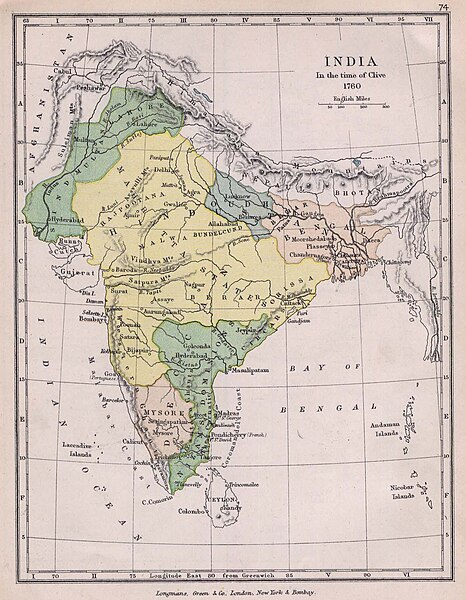The Third Battle of Panipat took place on 14 January 1761, at Panipat (Haryana State, India), about 60 miles (95.5 km) north of Delhibetween a northern expeditionary force of the Maratha Confederacy and a coalition of the King of Afghanistan Ahmad Shah Abdali with 2 Indian muslim allies --- the Rohilla Afghans of the Doab, and the Nawab of Oudh Shuja-ud-Daulah. Militarily speaking, the battle pitted the French-supplied[1] artillery and cavalry of the Marathas against the heavy cavalry and mounted artillery(zamburak and jizail) of the Afghans and Rohillas led by Ahmad Shah Durrani and Najib-ud-Daulah, both ethnic Pashtuns. The former is also known as Ahmad Shah Abdali. The battle is considered one of the largest battles fought in the 18th century[2], and has perhaps the largest fatalities in a single day reported in a classic formation battle between two armies.
The decline of the Mughal Empire following the 27 year Mughal-Maratha war (1680-1707) had led to rapid territorial gains for the Maratha Confederacy. Under Peshwa Baji Rao, Gujarat and Malwa came under Maratha control. Finally, in 1737, Baji Rao defeated the Mughals on the outskirts of Delhi, and brought much of the former Mughal territories south of Delhi under Maratha control. Baji Rao's son, Balaji Baji Rao (a.k.a Nana Saheb) further increased the territory under Maratha control by invading Punjab in 1758. This brought the Marathas into direct confrontation with the Durrani empire of Ahmad Shah Abdali. In 1759, he raised an army from the Pashtun tribes and made several gains against the smaller Maratha garrisons in Punjab. He then joined with his Indian allies - the Rohilla Afghans of the Doab, forming a broad coalition against the Marathas. The Marathas, under the command of Sadashivrao Bhau, responded by gathering an army of between 45,000–60,000, which was accompanied by roughly 200,000 non-combatants, several of whom were pilgrims desirous of making pilgrimages at Hindu holy sites of North India. The Marathas started their northward journey from Patdur on the 14th of March, 1760. The slow-moving Maratha camp finally reached Delhi on the 1st of August, 1760, and took Delhi the next day. There followed a series of skirmishes along the banks of the riverYamuna, and a battle at Kunjpura, which the Marathas won against a Afghan garrison of about 15000 (at this time, Abdali and the other Afghan forces were on the eastern side of the Yamuna river). However, Abdali daringly crossed the river Yamuna on the 25th of October at Baghpat, cutting of the Maratha camp from their base in Delhi. This eventually turned into a two-month-long siege led by Abdali against the Marathas in the town of Panipat. During the siege, both sides tried to cut off the other's supplies. At this, the Afghans were considerably more effective, so that by the end of November 1760, they had cut off almost all food supplies into the besieged Maratha camp (which had about 250,000 to 300,000, most of whom were non-combatants). According to all the chronicles of the time, food in the Maratha camp ran out by late December or early January and cattle died by the thousands. Starvation deaths of soldiers began to be reported by early January. On the 13th of January, the Maratha chiefs begged their command Sadashiv Rao Bhau to be led to die in battle than perish by starvation. The next day, the Marathas left their camp before dawn and marched south towards the Afghan camp in a desperate attempt to break the siege. The two armies came face to face around 8am, and the battle raged till evening.
The specific site of the battle itself is disputed by historians but most consider it to have occurred somewhere near modern day Kaalaa Aamb and Sanauli Road. The battle lasted for several days and involved over 125,000 men. Protracted skirmishes occurred, with losses and gains on both sides. The forces led by Ahmad Shah Durrani came out victorious after destroying several Maratha flanks. The extent of the losses on both sides is heavily disputed by historians, but it is believed that between 60,000–70,000 were killed in fighting, while numbers of the injured and prisoners taken vary considerably. The result of the battle was the halting of further Maratha advances in the North, and a destabilization of their territories, for roughly 10 years.
Contents[hide] |

No comments:
Post a Comment